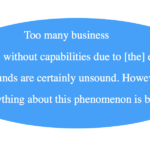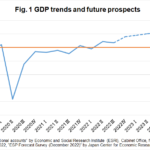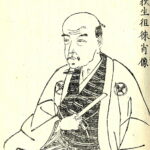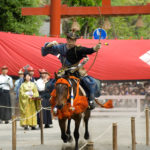By the time you read this article, the Reiwa era of “beautiful harmony” will have begun. What can we expect from Japan in the Reiwa years to come? Odaki Kazuhiko comments.
Emperor Akihito will step down at the end of April and Crown Prince Naruhito will be enthroned as the new emperor on May 1. The names of Japan’s historical periods or eras are changed in accordance with imperial succession. The names, written in Chinese characters of good omen, are selected to symbolize the period to come. The present period name, until May 1, is Heisei, which means “peaceful” and “quiet.” The name of the new era is Reiwa, which means “beautiful harmony.”
During the thirty years of Heisei, from 1989 to 2019, massive earthquakes struck both eastern and western Japan, and these two huge earthquakes both had large death tolls. However, the Heisei period was, on the whole, a quiet and peaceful one, as its name showed. Heisei was an era when there were no wars, both domestic crime and poverty declined, and people were able to enjoy leading satisfactory lives.
During the thirty years of Heisei, the Japanese economy was also quiet. Japan’s real GDP increased about 1.4 times during the period. An increase of 1.4 times in thirty years is very slow progress. It means that the Japanese economy grew at an annual rate of about 1.1%.
At the beginning of Heisei, Japan ranked on top of the global economy. Seven of the top ten companies and fourteen of the top twenty companies in terms of the market capitalization of the stock market were Japanese companies. Industrial products around the world were produced in Japan and in particular, a majority of high-tech products were produced in Japan. Stadiums around the globe were adorned with Japanese companies’ advertisements, and Japanese products were associated with an image of advanced technology and high quality. There were Japanese tourists all over the world, and Japanese companies bought out office buildings and art works around the world. The Japanese yen was also strong, and Japan enjoyed high wages and prices.
During the thirty years of Heisei, Western countries grew steadily and Asian countries grew rapidly. The Japanese economy hardly grew, however. No Japanese companies ranked among the top twenty in the world’s stock market capitalization rankings. Many high-tech products came to be designed in the United States and produced in China. Silicon Valley, which was revived by IT technology, and European countries, which were previously stagnant, are renewing their infrastructures and social systems. But the Japanese changes are very small and slow.
The stagnation of the Japanese economy became a subject matter of interest to scholars all over the world as well as the Japanese. In the past, it was pointed out that Japan’s finance systems were problematic. Because the collapse of the real estate bubble at the beginning of Heisei caused real estate prices to decrease to a third, which resulted in many banks being liquidated, it was natural for the economy to face a major problem. But even after the problem of real estate and the banks was solved, the Japanese economy did not grow.
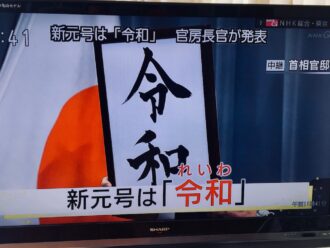
NHK TV announces the name of the new era, “Reiwa”
Currently, it is considered that the declining birthrate and aging population can be attributed to the sluggishness of the Japanese economy. However, it is during the Reiwa period, not during the Heisei period, that the declining birthrates and aging population will have a serious impact on the economy. Although the Heisei period was one when the working population was at its largest and richest, the economy did not grow.
A major reason for Japan’s stagnation was that the country lost its advantage in the electronics and IT industries that had a major share in its economy. Of course, during the Heisei period, electronics and IT technologies made significant progress in Japan as well. But because the technological advances in foreign countries outpaced those of Japan, Japan was caught up with and overtaken. Japan is no longer a country that sits on top of advanced technologies. Today, foreign exchange rates lean significantly toward a weaker yen and Japan has become a country with low wages and prices; nevertheless, Japan cannot export smartphones and software.
The Rise of the Individual
How will things go in the Reiwa period? The burden of the aging society will rapidly become heavier. In addition, Japan will finally lose its advantage in the automobile industry after the electronics and IT industries. It is also predicted that another huge natural disaster will occur.
Amid this situation, what will the beauty and harmony during the Reiwa period be? Individuals will definitely be valued during the Reiwa period as a result of the decrease in the population. A small population means rarity and preciousness. Younger generations with a smaller population have already been trained with a great deal of care and attention by society and are now able to receive relatively higher salaries. Long work hours and oppressive directions are disappearing. People are becoming able to lead a more beautiful life. It can be predicted that Japan will become more stagnant and will be shouldered with more difficulties during the Reiwa period than during the thirty years of Heisei. But even under these circumstances, it is Japan’s hope that the virtues of regard for individuals and enjoying life, which Japan has lacked to date, will be achieved in Japan as well.
ODAKI Kazuhiko is a professor at Nihon University and consulting fellow at the Research Institute for Economy, Trade and Industry.



